This is Part 12 from 125 Building Blocks for Your Bakery Business
The Best Mixers
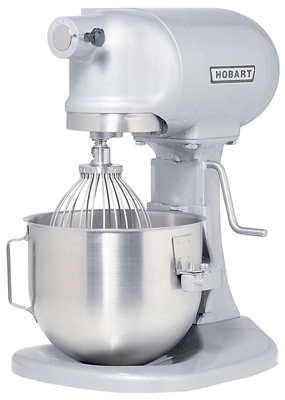
Small Tabletop Mixers
Every bakery needs at least one small stand mixer (6-10 quart size) for making small test batches of doughs and batters. This is the type of investment that most home bakers have probably already made. KitchenAid is a popular brand of mixer used in commercial kitchens to make small batches.
The Essential 10 Quart Bakery Mixer
The next logical jump up in size is a 20-quart mixer. As soon as you get into a commercial kitchen, this is another must-have. The most popular brand is called Hobart. Hobarts are built to last. Their 20-quart mixer is a solid and powerful tabletop machine. You can save a lot of money buying one used. Do check to make sure the electrical voltage of the model you choose is compatible with your power outlets.
High Volume Mixers
Above the 20-quart, if you have the space and the potential for expansion, I recommend investing in an 80-quart mixer that has 40-quart bowl attachments. That way, you have some flexibility in terms of batch size while only having to invest in the one large machine. This type of planetary floor mixer with the dual bowl options provides the most range in terms of production volume. For large machines like this, busy bakeries typically own two sets of bowls, paddles, and whisks for each size, so that they can begin a new batch of batter without having to stop, clean, and dry the bowl every time. Again, the preferred brand is Hobart.
Mixers come in all different sizes. I have worked in bakeries with planetary floor mixers as large as 400 quarts.
The Safety Screen
Note that many modern versions of mixers have safety screens installed. This type of machine won’t start unless the screen is closed. Although this safety feature is helpful in terms of preventing injuries, production-wise, it is messy and inconvenient. Since many types of cake batters and frostings are made by pouring wet or dry ingredients into the machine while it’s in the process of mixing, the screen is not a desirable feature. For example, when making Italian buttercream, you have to pour sticky softball sugar into the egg whites as they are whipping. Then you have to add greasy globs of softened butter. You don’t want to have to pour or jam these kinds of ingredients through a metal screen. For this reason, I recommend looking for a mixer with no screen.
Speed Racks
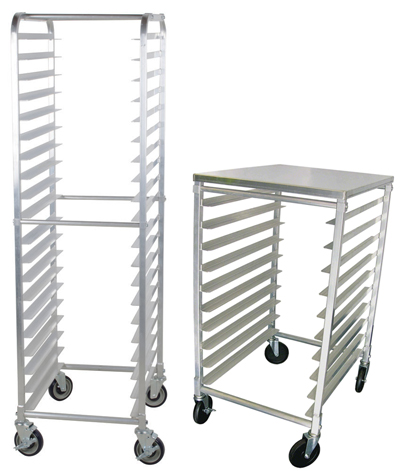
A speed rack is a kind of mobile shelving unit fitted for half- and/or full-sized sheet pans. Speed racks are multi-purpose. They may be used for temporarily holding product, cooling product, and moving product safely around a kitchen. They also double as permanent shelving/storage units. They come in many different sizes with different levels of spacing between slats. Speed racks are an excellent investment. If you are going to make the investment, you can save some money buying them used. Look for the heavy, robust kind with good quality, fully intact wheels.
The Best Ovens
The starter oven for many small bakeries is the convection-style rack oven. A convection-style oven is one in which forced air is circulated throughout the inside of the oven during baking. This ensures a more even distribution of heat so that food bakes more efficiently and consistently. Convection ovens are so much more efficient that a recipe which normally calls for a baking temperature of 350°F (177°C) for 20 minutes will need to be adjusted to bake in convection at 325°F (163°C) for 15 minutes.
Vulcan is a popular brand of convection oven that I recommend. Note that all ovens require the installation of a ventilation hood to expel hot exhaust.
The Fan Function
I recommend the kind of convection oven that allows you to turn the fan function on and off. The reason is because some baked goods do not perform as well under windy conditions. Light, egg white-based products such as meringues, soufflés, and angel food cake get blown around in a convection environment. For such items, it’s better to be able to turn the convection function off.
Rotating Rack Convection Oven
The next logical step up from a rack oven is a rotating-rack convection oven. Although there are many other types of large ovens (pizza style or band ovens), the rotating-rack oven is the one I have found to be most efficient as well as capable of yielding the finest, most consistent results when it comes to baked goods.
The rotating-rack oven works with removable, mobile racks on wheels. They look like speed racks but are designed to withstand the heat of baking. They clip in and out of the top of the oven. When the door is closed, the clip lifts the rack in the air and rotates it around during baking. Between the forced convection air and the rotation of the racks, this yields favorable results at a high-volume capacity. Without the forced air and rotation in this sized oven, you would run into consistency problems, with items on the top or bottom baking slower than items in the middle. The brand of rotating rack convection oven that I have had the best experience with is Revent.
The Right Prep Tables
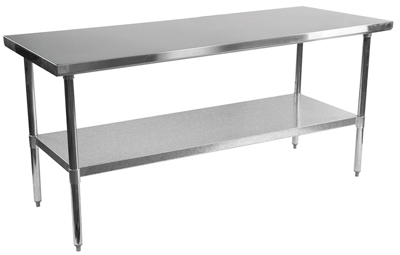
In a bakery, stainless steel prep tables are the easiest to clean and maintain. A wooden table is also a good item to have. There are some advantages to a wood surface when it comes to rolling out and cutting certain types of doughs such as croissant. Wood is naturally anti-bacterial so it’s rather clean compared to some other porous materials such as plastic. Marble is another potential consideration if you are going to be in the business of tempering chocolate. Otherwise, it’s not necessary.
For start-up bakeries, I would invest in one large wooden tabletop (if needed) and two stainless steel prep tables to start.
Cold Storage
There are three styles of refrigerators and freezers common at the commercial kitchen level:
- Reach-in with racks (for storing ingredients)
- Reach-in with slats (for storing products on sheet pans)
- Walk-in/Roll-in (for larger-volume operations, you can roll speed racks stocked with product right in through the door)
I recommend this guide to commercial grade freezer and refrigeration units. It contains excellent tips for choosing what makes the most sense for your kitchen.
Shelving
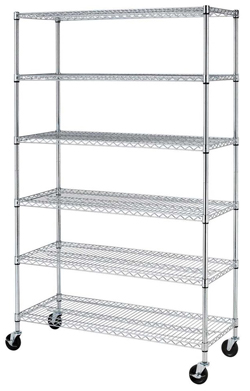
Wire metro rack shelving is the most common type seen in commercial kitchens. Depending on where they will be used (in a moist environment like a refrigerator versus in a dry storage area), you will need to invest in the appropriate style. Units designed for refrigeration have special coating so they don’t rust. The advantage to this kind of slotted wire shelving is that it’s sturdy and allows cool air to circulate. These types of shelves often are adjustable, which is a useful feature to have. You can also install them with castors so they can be wheeled around. The only aspect of these shelves that I don’t like is that they are difficult to clean.
Dunnage racks are another type of popular commercial shelving unit. They have only one low level for storing large boxes, containers, bags, and heavy items off the floor. Since it is against the health code to store food directly on the floor, dunnage racks are often used to prop up heavy items like sacks of sugar and flour.
Baking Pans
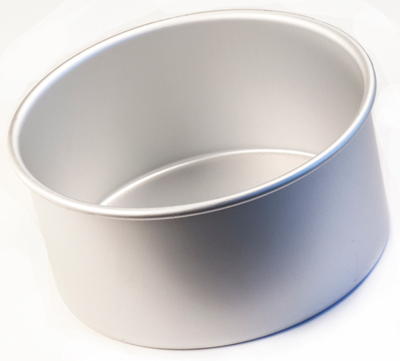
When it comes to sheet pans, the best long-term investment for your bakery is thick gauge aluminum pans in both half and full sheet size. Stainless steel is also an option that is easier to clean and maintain, but it’s not as good for baking or commercial wear and tear. I do not recommend baking directly on the surface of these kinds of pans. Using parchment paper liners will help preserve the metal.
When it comes to cake pans, the best long-term investment for your bakery is deep, thick gauge solid aluminum pans.
The advantages to solid, deep, aluminum pans
- The thick metal and high walls help buffer the heat so that cakes bake more evenly without developing as brown of a crust on the outside.
- You can pour twice as much batter in a deep pan, baking more at once.
- In doing so, you cut the number of pans that must be washed in half.
- This type of pan doubles as a mold to fill a layer cake, which yields excellent results.
3″ deep pans are the best fit for home ovens. 4″ deep pans are better for bakeries that have the advantage of more oven space. I prefer Fat Daddio’s brand cake pans. They are seamless, high quality, and maintain well because of their strong lip. You may buy Fat Daddio’s pans directly from the manufacturer as long as you purchase in high volume.
The Fat Daddio’s website also offers batter capacity charts for their round and square cake pans, in case you want to know how much batter should go into each sized pan.
Sheeters
A sheeter is a machine that does the job of rolling out dough or fondant. It takes up quite a bit of space but will save you tons of time rolling out whatever needs rolling. For limited space, you can invest in a “single pass” or “double pass” unit. This is the vertically oriented kind of sheeter where the dough enters at the top and exits at the bottom or side. This works fine for fondant but is not as good for more delicate cookie doughs. If you have plenty of space in your kitchen, you can invest in a “reversible sheeter,” which cranks the dough back and forth on bands. This kind of sheeter looks like a conveyor belt with a rolling mechanism in the middle. It accommodates larger sheets of dough and keeps everything flat, so it can even be used for more delicate doughs.
Sheeters can be simple or sophisticated. In larger bakeries, I’ve worked with the digital kind of sheeter that can be programmed, automated, and linked with other units to build efficient assembly lines on which the product is rolled out, cut, filled and shaped into pastries using robotic appendages.
No matter what size investment you make, the brand of sheeter I most recommend is Rondo.
Tools & Equipment
For all other miscellaneous items such as bowls, spatulas, and containers, I recommend shopping at a restaurant supply store. You can find better deals when you shop for overstock or buy your equipment used. I would avoid Restaurant Depot for this type of purchase. Although they carry a good selection of merchandise, it tends to be pricey. I have found better deals at local independently owned supply shops and food establishments in the process of liquidating.
In many cases, the equipment and tools you buy for a commercial kitchen do not look like the kinds of tools you would buy for your home. Make sure you invest in equipment that is commercial grade. It should be shatter-proof, rust-proof, and built to withstand wear and tear.
This is the end of Part 12 from 125 Building Blocks for Your Bakery Business. Return to the Table of Contents or proceed to Part 13 – Bakery Operations and Locations
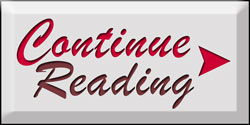
Related Material




